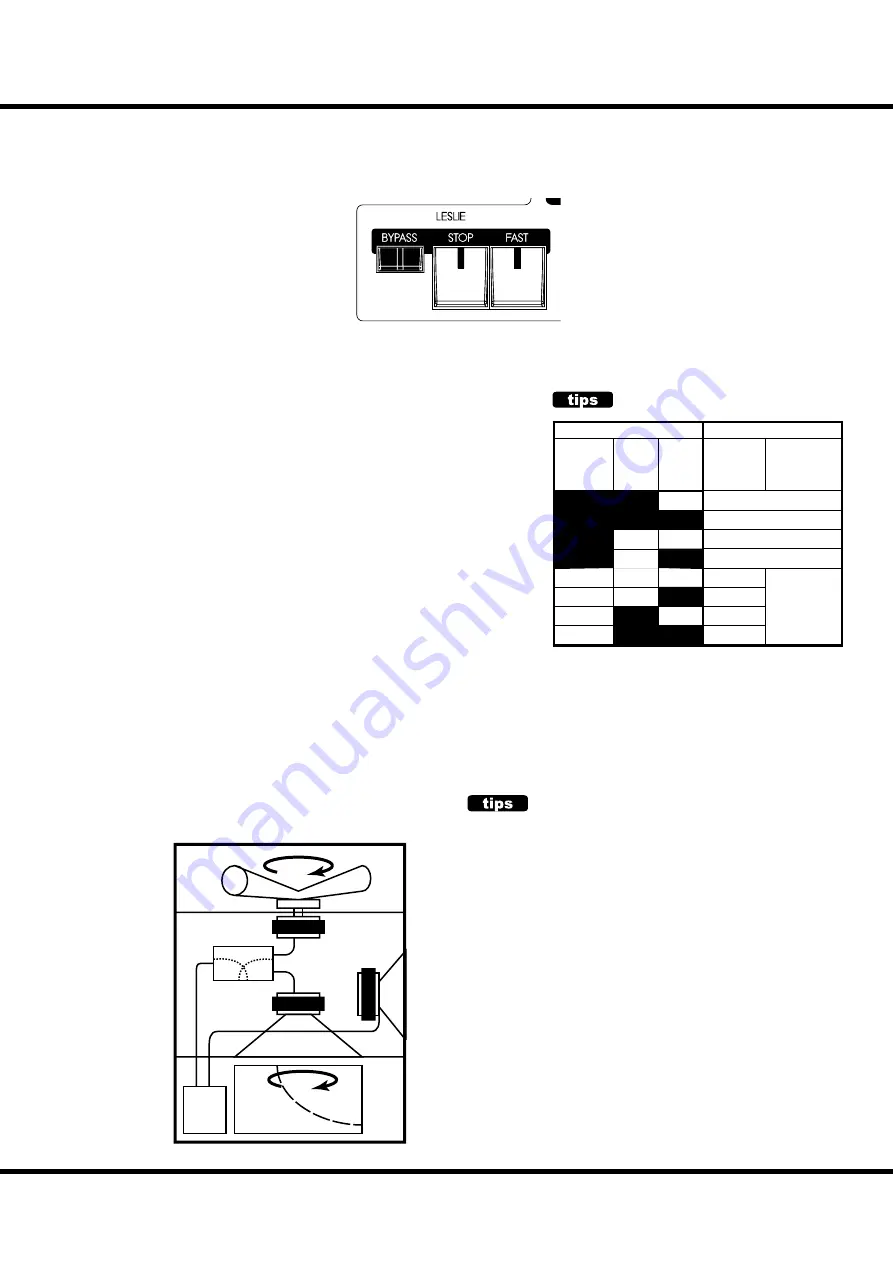
49
Setting Up
LESLIE
Th
e rotating sound of the LESLIE Speaker is the natural partner of the Ham-
mond Organ. A Digital version is built-in to the XK-1C; and the controls will
also function with a connected external Leslie speaker.
[ FAST] button
Toggles the mode of the rotor by two steps. Every press switches
the status. When the light is ON, the mode is FAST, and when it
is OFF, it is not.
[ STOP] button
To toggle the FAST and SLOW when you pressed the [FAST] but-
ton, press this button and the light OFF.
To toggle the FAST and STOP when you pressed the [FAST] but-
ton, press this button and the light ON.
[ BYPASS] button
When the light is OFF, the sound is output from the rotary chan-
nel (Leslie eff ect).
To bypass the Leslie eff ect, press this button and the light will go
ON. Regardless of the status of the [FAST], [STOP] buttons, the
sound is output from the stationary channel.
NOTE: Leslie Eff ect is available except Pipe type.
NOTE: You can fi ne-tune the parameters of the Leslie eff ect. (P. 78)
BUTTON
MODE
BYPASS
STOP
FAST
CH=1
CH=3,
on-board
Leslie effect
Off Off
On
Fast
Off Off Off
Slow
Off
On
On
Fast
Off
On
Off
Stop
On
On
On
Fast
Bypass
On
On
Off
Stop
On
Off
On
Fast
On
Off Off
Slow
STATUS CHART OF EACH BUTTON
800Hz
Ampli-
fier
Horn
Driver
Woofer
Bass
Rotor
Horn
Rotor
Stationary
Speaker
WHAT IS THE LESLIE EFFECT?
The Leslie Speaker was invented by Donald Leslie in
1941 to make the Hammond Organ sound like a Thea-
tre Pipe Organ. Using motor-driven rotating horns and
baffl
es, Leslie’s invention gave the organ a rich and
moving tone, which quickly became it’s own unforget-
table sound.
In its basic form, the Leslie Speaker has an built-in
amplifi er and two rotors; the “Horn Rotor” for treble
and the “Bass Rotor” for bass which are each fed by a
custom-designed driver/speaker. The combination of
the two utilizes the “Doppler Eff ect” to give the unique
Leslie “swirling” sound.
Some models have not only rotors but also a fi xed
speaker. The circuit for sending the sound to the rotor
is called the “Rotary Channel”, and that for the fi xed
speaker is called the “Stationary Channel”.
The Digital Leslie on-board the XK-1C employs all the
proprietary concepts used in the physical speakers, but
realizes them in the digital realm. It is recommended
that you run the Main Outputs “in stereo” to get the full-
est eff ect.
Diagram of 3 channel Leslie Speaker
Summary of Contents for XK-1c
Page 5: ...5 Introduction INTRODUCTION...
Page 14: ...1 Owner s Manual 14 NAMES AND FUNCTIONS continued...
Page 15: ...15 HOOK UP...
Page 21: ...21 GETTING READY TO PLAY...
Page 33: ...33 SETTING UP...
Page 56: ...1 Owner s Manual 56...
Page 57: ...57 USING THE CONTROL PANEL...
Page 67: ...67 SETTING THE PARAMETERS...
Page 75: ...75 Setting the Parameters...
Page 98: ...1 Owner s Manual 98...
Page 99: ...99 MIDI...
Page 110: ...1 Owner s Manual 110...
Page 111: ...111 SAVE THE SETUP...
Page 119: ...119 Troubleshooting...
Page 121: ...121 APPENDIX...
Page 138: ...1 Owner s Manual 138 V Vibrato Chorus 29 47 77 Vx 36 42 W Wah Wah 88 Z Zones 106...
Page 140: ...Printed in China HAMMOND SUZUKI LTD Hamamatsu Japan 00457 40189 V1 00 130806...
















































